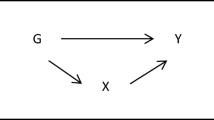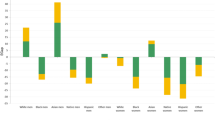Abstract
This paper examines the implications of the standard Heckman (Heckit) correction for selectivity bias in wage and earnings functions that are subsequently used in wage decompositions. Even when justified, Heckit selectivity correction introduces some fundamental ambiguities in the context of wage decompositions. The ambiguities arise from group differences in the selection term which consists of a parameter multiplied by the Inverse Mills Ratio (IMR). The parameter is identified as the product of the standard deviation of the errors in the wage equation and the correlation between the wage equation error and the selection equation error. How should group differences in these parameters be interpreted in terms of structural differences and endowment effects? The same issue arises with respect to group differences in the IMR which reflect nonlinear group differences in the determinants of selection and in the probit coefficients.
Similar content being viewed by others
References
Blau, F.D. and Kahn, L.M.: Swimming upstream: Trends in the gender wage differential in the 1980's, J. Labor Economics 15 (1997), 1–42.
Blinder, A.S.: Wage discrimination: Reduced form and structural estimates, J. Human Resources 8 (1973), 436–455.
Boymond, M., Flückiger, Y. and Silber, J.: Wage discrimination and occupational segregation by gender: Some evidence from Swiss data, mimeo, Geneva, 1994.
Cragg, J.: Some statistical models for limited dependent variables with applications to the demand for durable goods, Econometrica 39 (1971), 829–844.
Datta Gupta, N., Oaxaca, R.L. and Smith, N.: The Danish gender wage gap and wage determination in the private and public sectors, In: S. Gusstafson and D. Meulders (eds.), Gender and the Labour Market: Econometric Evidence on Obstacles in Achieving Gender Equality, AEA Macmillan Series, 2000.
Duncan, G.M. and Leigh, D.E.: Wage determination in the union and nonunion sectors: A sample selectivity approach, Industrial and Labor Relations Review 34 (1980), 24–34.
Gronau, R.: Wage comparisons: A selectivity bias, J. Political Economy 82 (1974), 1119–1143.
Heckman, J.: The common structure of statistical models of truncation, sample selection and limited dependent variables and a simple estimator for such models, Annals of Economic and Social Measurement 5 (1976), 475–492.
Heckman, J.: Sample selection bias as a specification error, Econometrica 47 (1979), 153–163.
Juhn, C., Murphy, K.M. and Pierce, B.: Accounting for the slowdown in black-white wage convergence, In: M.H. Kosters (ed.), Workers and Their Wages: Changing Patterns in the United States, American Enterprise Institute Press, Washington, 1991.
Manski, C.: Anatomy of the selection problem, J. Human Resources 24 (1989), 343–360.
Manski, C.: Identification Problems in the Social Sciences, Harvard University Press, Cambridge, MA, 1995.
Neumark, D.: Employers' discriminatory behavior and the estimation of wage discrimination, J. Human Resources 23 (1988), 279–295.
Oaxaca, R.L.: Male—female wage differentials in urban labor markets, International Economic Review 14 (1973), 693–709.
Oaxaca, R.L. and Ransom, M.: Searching for the effect of unionism on the wages of union and nonunion workers, J. Labor Research 9 (1988), 139–148.
Oaxaca, R.L. and Ransom, M.: On discrimination and the decomposition of wage differentials, J. Econometrics 61 (1994), 5–21.
Reimers, C.: Labor market discrimination against hispanic and black men, The Review of Economics and Statistics 65 (1983), 570–579.
Suen, W.: Decomposing wage residuals: Unmeasures skill or statistical artifact, J. Labor Economics 15 (1997), 555–566.
Vella, F.: Estimating models with sample selection bias: A survey, J. Human Resources 33 (1998), 127–169.
Author information
Authors and Affiliations
Rights and permissions
About this article
Cite this article
Neuman, S., Oaxaca, R.L. Wage Decompositions with Selectivity-Corrected Wage Equations: A Methodological Note. The Journal of Economic Inequality 2, 3–10 (2004). https://doi.org/10.1023/B:JOEI.0000028395.38694.4b
Issue Date:
DOI: https://doi.org/10.1023/B:JOEI.0000028395.38694.4b




